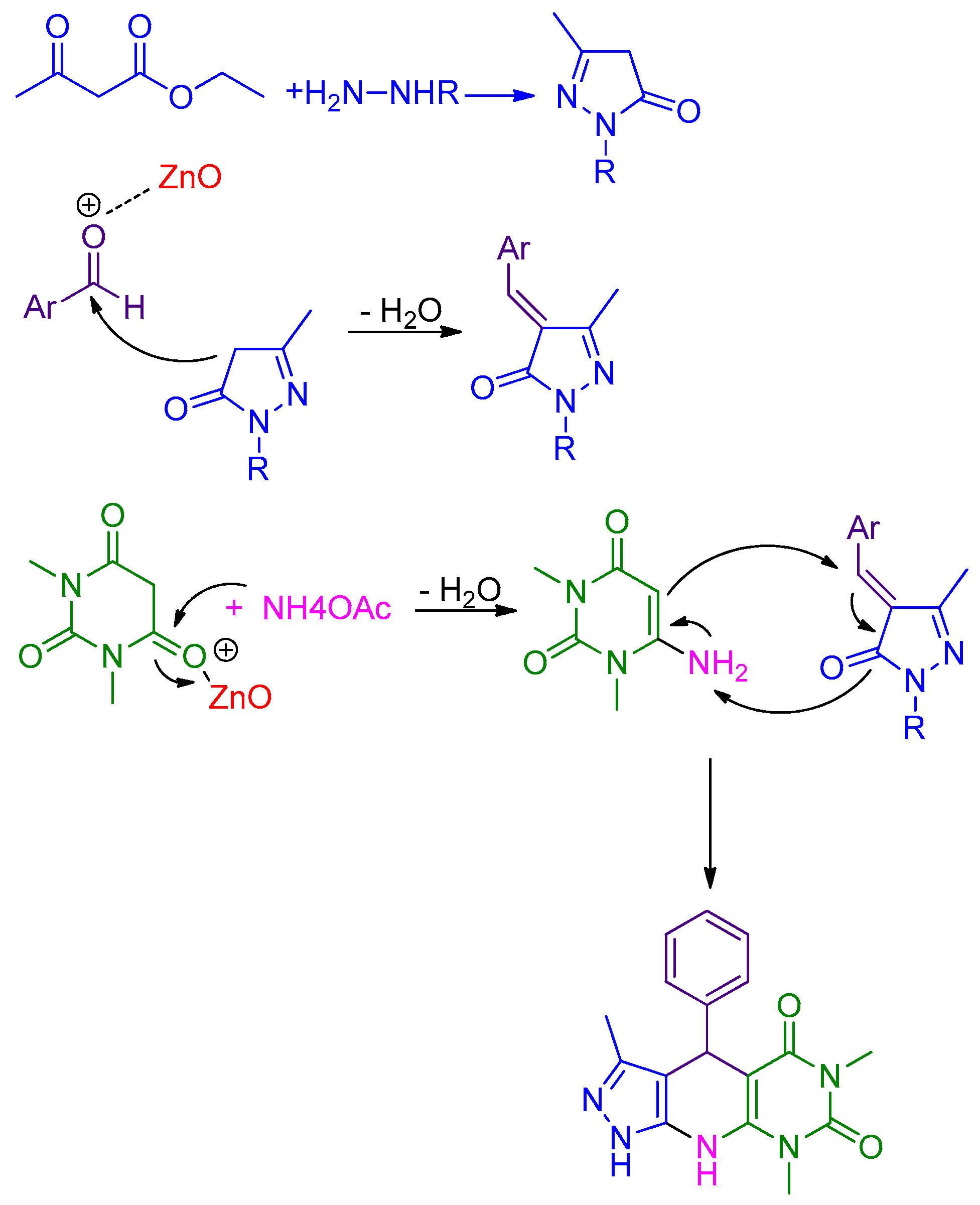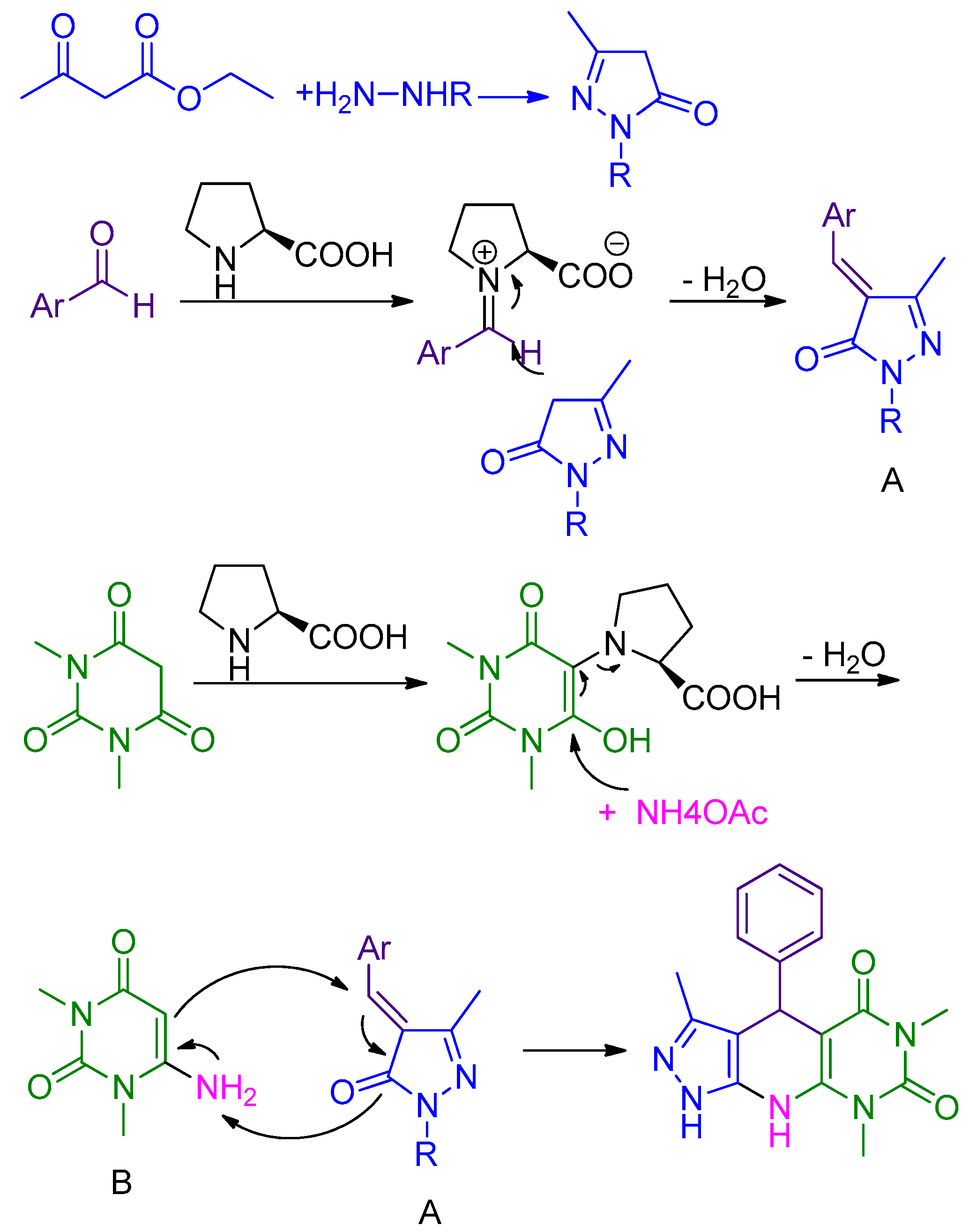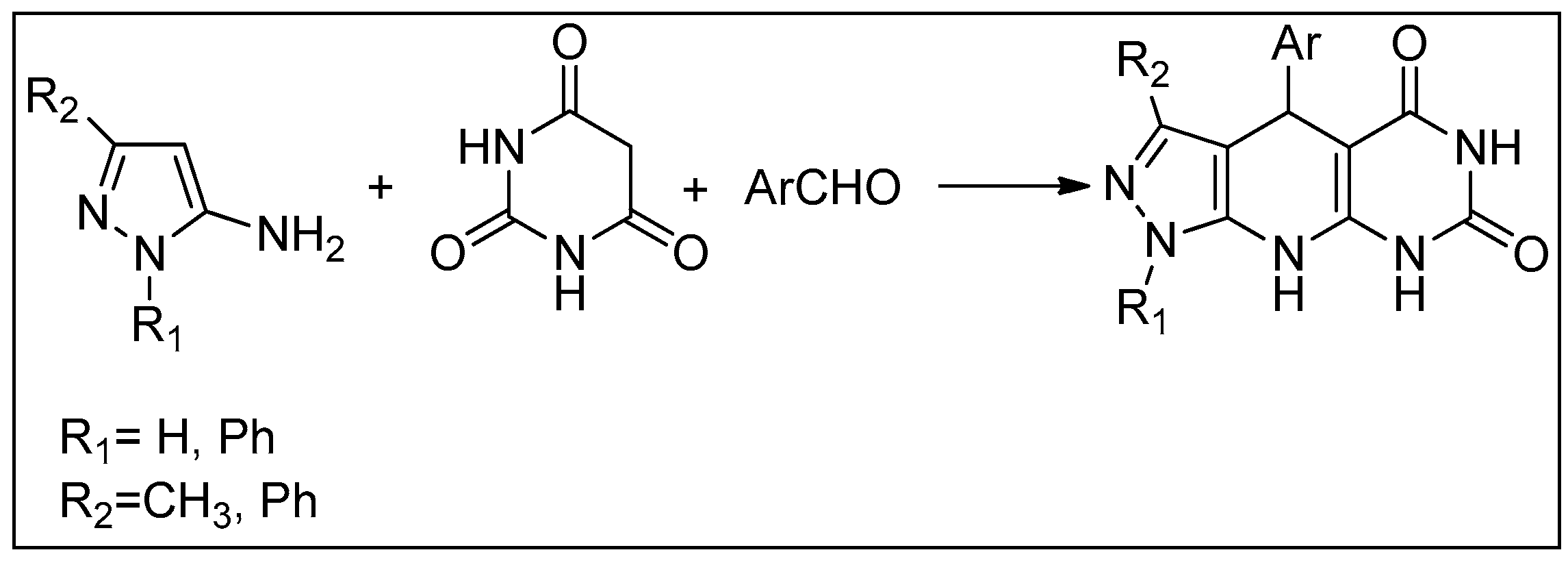A Novel and Efficient Five-Component Synthesis of Pyrazole Based Pyrido[2,3-d]pyrimidine-diones in Water: A Triply Green Synthesis
Abstract
:1. Introduction
2. Results
3. Experimental
3.1. General Procedure
3.1.1. Synthesis of Pyrazolo-[4′,3′:5,6]pyrido[2,3-d]pyrimidine-diones: Using 4-Component Reaction
3.1.2. Synthesis of Pyrazolo-[4′,3′:5,6]pyrido[2,3-d]pyrimidine-diones Using 5-Component Reaction
3.1.3. Synthesis of Pyrazolo-[4′,3′:5,6]pyrido[2,3-d]pyrimidine-diones: Using 4-Component Reaction
3.2. Spectral Data
4. Conclusions
Supplementary Materials
Acknowledgments
Author Contributions
Conflicts of Interest
References
- Chan, M. World Malaria Report 2011 Summary (Report); World Health Organization: Geneva, Switzerland, 2011. [Google Scholar]
- Russell, D.G.; Barry, C.E.; Flynn, J.L. Tuberculosis: What We Don’t Know Can, and Does, Hurt Us. Science 2010, 328, 852–856. [Google Scholar] [CrossRef] [PubMed]
- Ballell, L.; Field, R.A.; Duncan, K.; Young, R.J. New Small-Molecule Synthetic Antimycobacterials. Antimicrob. Agents Chemother. 2005, 49, 2153–2163. [Google Scholar] [CrossRef] [PubMed]
- Cegielski, J.P.; Chin, D.P.; Espinal, M.A.; Frieden, T.R.; Cruz, R.R.; Talbot, E.A.; Weil, D.E.C.; Zaleskis, R.; Raviglione, M.C. The global tuberculosis situation. Progress and problems in the 20th century, prospects for the 21st century. Infect. Dis. Clin. N. Am. 2002, 16, 1–58. [Google Scholar] [CrossRef]
- Selvam, T.P.; James, C.R.; Dniandev, P.V.; Valzita, S.K. A mini review of pyrimidine and fused pyrimidine marketed Drugs. Res. Pharm. 2012, 2, 1–9. [Google Scholar]
- Agarwal, A.; Srivastava, K.; Puri, S.K.; Chauhan, P.M. Synthesis of 2,4,6-trisubstituted pyrimidines as antimalarial agents. Bioorg. Med. Chem. 2005, 13, 4645–4650. [Google Scholar] [CrossRef] [PubMed]
- Matloobi, M.C.; Kappe, O. Microwave-Assisted Solution- and Solid-Phase Synthesis of 2-Amino-4-arylpyrimidine Derivatives. J. Comb. Chem. 2007, 9, 275–284. [Google Scholar] [CrossRef] [PubMed]
- Gadhachanda, V.R.; Wu, B.; Wang, Z.; Kuhen, K.L.; Caldwell, J.; Zondler, H.; Walter, H.; Havenhand, M.; He, Y. Antibacterial 5′-O-(N-dipeptidyl)-sulfamoyladenosines. Bioorg. Med. Chem. 2007, 17, 260–265. [Google Scholar] [CrossRef] [PubMed]
- Chang, L.C.W.; Spanjersberg, R.F.; von Frijtag Drabbe Kunzel, J.K.; Mulder-Krieger, T.; van den Hout, G.; Beukers, M.W.; Brussee, J.; Jzerman, A.P. 2,4,6-Trisubstituted Pyrimidines as a New Class of Selective Adenosine A1 Receptor Antagonists. J. Med. Chem. 2004, 47, 6529–6540. [Google Scholar] [CrossRef] [PubMed]
- Capdeville, R.; Buchdunger, E.; Zimmermann, J.; Matter, A. Glivec (STI571, imatinib), a rationally developed, targeted anticancer. Nat. Rev. Drug Discov. 2002, 1, 493–502. [Google Scholar] [CrossRef] [PubMed]
- Zaki, M.E.A.; Soliman, H.A.; Hiekal, O.A.; Rashad, A.E.Z. Pyrazolopyranopyrimidines as a Class of Anti-Inflammatory Agents. Z. Naturforschung 2006, 61c, 1–5. [Google Scholar] [CrossRef]
- Ozeki, K.; Ichikawa, T.; Takehara, H.; Tanimura, K.; Sato, M.; Yaginuma, H. Studies on antiallergy agents. III. Synthesis of 2-anilino-1,6-dihydro-6-oxo-5-pyrimidine carboxylic acids and related compounds. Chem. Pharm. Bull. 1989, 37, 1780–1787. [Google Scholar] [CrossRef] [PubMed]
- Hulme, C.; Gore, V. “Multi-component Reactions: Emerging Chemistry in Drug Discovery” “from Xylocain to Crixivan”. Curr. Med. Chem. 2003, 10, 51–80. [Google Scholar] [CrossRef] [PubMed]
- Dömling, A.; Ugi, I. Multicomponent Reactions with Isocyanides. Angew. Chem. Int. Ed. 2000, 39, 3169–3210. [Google Scholar] [CrossRef]
- Shaabani, A.; Seyyedhamzeh, M.; Maleki, A.; Behnam, M.; Rezazadeh, F. Synthesis of fully substituted pyrazolo[3,4-b]pyridine-5-carboxamide derivatives via a one-pot four-component reaction. Tetrahedron Lett. 2009, 50, 2911–3020. [Google Scholar] [CrossRef]
- Sunderhaus, J.D.; Martin, S.F. Applications of Multicomponent Reactions to the Synthesis of Diverse Heterocyclic Scaffolds. Chem. Eur. J. 2009, 15, 1300–1308. [Google Scholar] [CrossRef] [PubMed]
- Li, C.-J. Organic reactions in aqueous media—With a focus on carbon-carbon bond formation. Chem. Rev. 1993, 93, 2023–2035. [Google Scholar] [CrossRef]
- Lindstrom, U.M. Stereoselective Organic Reactions in Water. Chem. Rev. 2002, 102, 2751–2772. [Google Scholar] [CrossRef] [PubMed]
- Breslow, R. Hydrophobic effects on simple organic reactions in water. Acc. Chem. Res. 1991, 24, 159–164. [Google Scholar] [CrossRef]
- Li, C.J. Organic Reactions in Aqueous Media with a Focus on Carbon–Carbon Bond Formations: A Decade Update. Chem. Rev. 2005, 105, 3095–3165. [Google Scholar] [CrossRef] [PubMed]
- Kobayashi, S. Asymmetric catalysis in aqueous media. Pure Appl. Chem. 2007, 79, 235–245. [Google Scholar] [CrossRef]
- Narayan, S.; Muldoon, J.; Glynn, M.G.; Fokin, V.V.; Kolb, H.C.; Sharpless, K.B. “On water”: Unique reactivity of organic compounds in aqueous suspension. Angew. Chem. Int. Ed. 2005, 44, 3275–3279. [Google Scholar] [CrossRef] [PubMed]
- Rothenberg, G. Catalysis: Concepts and Green Applications; Wiley-VCH: Weinheim, Germany, 2008. [Google Scholar]
- Rostamnia, S.; Doustkhah, E. Nanoporous silica-supported organocatalyst: A heterogeneous and green hybrid catalyst for organic transformations. RSC Adv. 2014, 4, 28238–28248. [Google Scholar] [CrossRef]
- Bazgira, A.; Khanaposhtani, M.M.; Soorki, A.A. One-pot synthesis and antibacterial activities of pyrazolo[40,30:5,6]pyrido[2,3-d]pyrimidine-dione derivatives. Bioorg. Med. Chem. Lett. 2008, 18, 5800–5803. [Google Scholar] [CrossRef] [PubMed]
- Satasia, S.P.; Kalaria, P.N.; Raval, D.K. Catalytic regioselective synthesis of pyrazole based pyrido[2,3-d]pyrimidine-diones and their biological evaluation. Org. Biomol. Chem. 2014, 12, 1751–1758. [Google Scholar] [CrossRef] [PubMed]
- Heravi, M.M.; Alishiri, T. Chapter One—Dimethyl Acetylenedicarboxylate as a Building Block in Heterocyclic Synthesis. Adv. Heterocycl. Chem. 2014, 113, 1–66. [Google Scholar]
- Heravi, M.M.; Talaei, B. Chapter Four-Ketenes as Privileged Synthons in the Syntheses of Heterocyclic Compounds. Part 1: Three- and Four-Membered Heterocycles. Adv. Heterocycl. Chem. 2014, 113, 143–244. [Google Scholar]
- Heravi, M.M.; Khaghaninejad, S.; Nazari, N. Chapter Five—Bischler–Napieralski Reaction in the Syntheses of Isoquinolines. Adv. Heterocycl. Chem. 2014, 112, 183–234. [Google Scholar]
- Heravi, M.M.; Zadsirjan, V. Chapter Five—Recent Advances in the Synthesis of Benzo[b]furans. Adv. Heterocycl. Chem. 2015, 117, 261–376. [Google Scholar]
- Heravi, M.M.; Talaei, B. Chapter Three—Ketenes as Privileged Synthons in the Syntheses of Heterocyclic Compounds Part 2: Five-Membered Heterocycles. Adv. Heterocycl. Chem. 2015, 114, 147–225. [Google Scholar]
- Heravi, M.M.; Fathi Vavsari, V. Chapter Two—Recent Advances in Application of Amino Acids: Key Building Blocks in Design and Syntheses of Heterocyclic Compounds. Adv. Heterocycl. Chem. 2015, 114, 77–145. [Google Scholar]
- Khaghaninejad, S.; Heravi, M.M. Chapter Three—Paal–Knorr Reaction in the Synthesis of Heterocyclic Compounds. Adv. Heterocycl. Chem. 2014, 111, 95–146. [Google Scholar]
- Heravi, M.M.; Khaghaninejad, S.; Mostofi, M. Chapter One—Pechmann Reaction in the Synthesis of Coumarin Derivatives. Adv. Heterocycl. Chem. 2014, 112, 1–50. [Google Scholar]
- Mirsafaei, R.; Heravi, M.M.; Ahmadi, S.; Moslemin, M.H.; Hosseinnejad, T. In situ prepared copper nanoparticles on modified KIT-5 as an efficient recyclable catalyst and its applications in click reactions in water. J. Mol. Catal. A Chem. 2015, 402, 100–108. [Google Scholar] [CrossRef]
- Nemati, F.; Heravi, M.M.; Elhampour, A. Magnetic nano-Fe3O4@TiO2/Cu2O core–shell composite: An efficient novel catalyst for the regioselective synthesis of 1,2,3-triazoles using a click reaction. RSC Adv. 2015, 5, 45775–45784. [Google Scholar] [CrossRef]
- Nemati, F.; Heravi, M.M.; Saeedi, R. Nano-Fe3O4 Encapsulated-Silica Particles Bearing Sulfonic Acid Groups as a Magnetically Separable Catalyst for Highly Efficient Knoevenagel Condensation and Michael Addition Reactions of Aromatic Aldehydes with 1,3-Cyclic Diketones. Chin. J. Catal. 2012, 33, 1825–1831. [Google Scholar] [CrossRef]
- Heravi, M.M.; Alishiri, T. Application of Nanomaterials in Heterocyclic Chemistry. Heterocycles 2012, 85, 545–586. [Google Scholar] [CrossRef]
- Hashemi, E.; Beheshtiha, S.Y.; Ahmadi, S.; Heravi, M.M. In situ prepared CuI nanoparticles on modified poly(styrene-co-maleic anhydride): An efficient and recyclable catalyst for the azide–alkyne click reaction in water. Transit. Met. Chem. 2014, 39, 593–601. [Google Scholar] [CrossRef]
- Heravi, M.M.; Hashemi, E.; Beheshtiha, S.Y.; Kamjou, K.; Toolabi, M. PdCl2 on modified poly(styrene-co-maleic anhydride): A highly active and recyclable catalyst for the Suzuki–Miyaura and Sonogashira reactions. J. Mol. Catal. A Chem. 2014, 394, 74–82. [Google Scholar] [CrossRef]
- Heravi, M.M.; Daraie, M.; Behbahani, F.K.; Malakooti, R. Green and Novel Protocol for One-Pot Synthesis of β-Acetamido Carbonyl Compounds Using Mn(bpdo)2Cl2/MCM-41 Catalyst. Synth. Commun. 2010, 40, 1180–1186. [Google Scholar] [CrossRef]
- Daraie, M.; Beheshtiha, Y.S.; Heravi, M.M. Synthesis of spirochromene derivatives catalyzed by Mn(bpyo)2/MCM-41 in water. Monatshefte Chem. 2015, 146, 191–198. [Google Scholar] [CrossRef]
- Heravi, M.M.; Daraie, M. Heterogeneous catalytic three-component one-pot synthesis of novel 8H-[1,3]dioxolo[4,5-g]chromenes by basic alumina in water. Mon. Chem. 2014, 145, 1479–1482. [Google Scholar] [CrossRef]
- Heravi, M.M.; Daraie, M. Mn(pbdo)2Cl2/MCM-41 as a green catalyst in multi-component syntheses of some heterocycles. Res. Chem. Intermed. 2015, 41, 1–10. [Google Scholar] [CrossRef]
- Heravi, M.M.; Khorasani, M.; Derikvand, F.; Bamoharram, F.F. Highly efficient synthesis of coumarin derivatives in the presence of H14[NaP5W30O110] as a green and reusable catalyst. Catal. Commun. 2007, 8, 1886–1890. [Google Scholar] [CrossRef]
- Heravi, M.M.; Bakhtiari, K.; Taheri, S. KHSO4: A catalyst for the chemo-selective preparation of 1,1-diacetates from aldehydes under solvent-free conditions. Green Chem. 2005, 7, 867–869. [Google Scholar] [CrossRef]
- Saeedi, M.; Heravi, M.M.; Beheshtiha, S.Y. One-pot three-component synthesis of the spiroacenaphthylene derivatives. Tetrahedron 2010, 66, 5345–5348. [Google Scholar] [CrossRef]
- Heravi, M.M.; Baghernejad, B.; Oskooie, H.A. A novel three-component reaction for the synthesis of N-cyclohexyl-3-aryl-quinoxaline-2-amines. Tetrahedron Lett. 2009, 50, 767–769. [Google Scholar] [CrossRef]
- Heravi, M.M.; Baghernejad, B.; Oskooie, H.A. A novel and facile synthesis of 2-(cyclohexylamino)-6,7-dihydro-3-aryl-1H-indole-4(5H)-ones via a one-pot multi-component reaction. Tetrahedron Lett. 2009, 49, 6106–6103. [Google Scholar] [CrossRef]
- Heravi, M.M.; Moghimi, S. An efficient synthesis of thiazol-2-imine derivatives via a one-pot, three-component reaction. Tetrahedron Lett. 2012, 53, 392–394. [Google Scholar] [CrossRef]
- Heravi, M.M.; Mousavizadeh, F.; Ghobadi, N.; Tajbakhsh, M. A green and convenient protocol for the synthesis of novel pyrazolopyranopyrimidines via a one-pot, four-component reaction in water. Tetrahedron Lett. 2014, 55, 1226–1228. [Google Scholar] [CrossRef]
- Heravi, M.M.; Behbahani, F.K.; Daraie, M.; Oskooie, H.A. Fe(ClO4)3·6H2O: A mild and efficient catalyst for one-pot three component synthesis of β-acetamido carbonyl compounds under solvent-free conditions. Mol. Divers. 2009, 13, 375–378. [Google Scholar] [CrossRef] [PubMed]
- Heravi, M.M.; Tajbakhsh, M.; Ahmadi, A.N.; Mohajerani, B. Zeolites. Efficient and Eco-friendly Catalysts for the Synthesis of Benzimidazoles. Mon. Chem. 2006, 137, 175–179. [Google Scholar] [CrossRef]
- Heravi, M.M.; Sadjadi, S.; Oskooie, H.A.; Hekmat Shoar, R.; Bamoharram, F.F. Heteropolyacids as Green and Reusable Catalysts for the Synthesis of 3,1,5-Benzoxadiazepines. Molecules 2007, 12, 255–262. [Google Scholar] [CrossRef] [PubMed]
- Shaabani, A.; Ghadari, R.; Ghasemi, S.; Pedarpour, M.; Rezayan, A.H.; Sarvary, A.; Seik Weng, N.G. Novel One-Pot Three- and Pseudo-Five-Component Reactions: Synthesis of Functionalized Benzo[g]- and Dihydropyrano[2,3-g]chromene Derivatives. J. Comb. Chem. 2009, 11, 956–959. [Google Scholar] [CrossRef] [PubMed]
- Lu, Z.; Xiao, J.; Wang, D.; Li, Y. An Efficient One-Pot Five-Component Tandem Sequential Approach for the Synthesis of Pyranopyrazole Derivatives via Suzuki Coupling and Multicomponent Reaction. Asian J. Org. Chem. 2015, 4, 487–492. [Google Scholar] [CrossRef]
- Fu, L.; Feng, X.; Zhang, J.; Hu, J.-D.; Xun, Z.; Wang, J.-J.; Huang, Z.-B.; Shi, D.-Q. Highly efficient construction of a bridged pentacyclic skeleton via a six-component domino reaction under microwave irradiation. Green Chem. 2015, 17, 1535–1545. [Google Scholar] [CrossRef]
- Basyouni, W.M.; El-Bayouki, K.A.M.; Tohamy, W.M.; Abbas, S.Y. Silica Sulfuric Acid: An Efficient, Reusable, Heterogeneous Catalyst for the One-Pot, Five-Component Synthesis of Highly Functionalized Piperidine Derivatives. Synth. Commun. 2015, 45, 1073–1081. [Google Scholar] [CrossRef]
- Dabiri, M.; Salehi, P.; Fakharian, M.; Movahed, S.K.; MaGee, D. New Convenient Five-Component One-Pot Synthesis of 3-Alkyl-6-amino-1,4-dihydro-4-{[(1,2,3-triazol-4-yl)methoxy]phenyl}pyrano[2,3-c]pyrazole-5-carbonitrile Derivatives. Helv. Chim. Acta 2015, 98, 633–641. [Google Scholar] [CrossRef]
- Nikbakht, A.; Ramezanpour, S.; Balalaie, S.; Rominger, F. Efficient and stereoselective synthesis of α-hydrazino tetrazoles through a pseudo five-component domino reaction. Tetrahedron 2015, 71, 6790–6795. [Google Scholar] [CrossRef]
- Teimouri, M.B.; Moghaddam, P.A.; Golbaghi, G. Pseudo-Five-Component Reaction between 3-Formylchromones, Meldrum’s Acid, Isocyanides and Primary Arylamines: Diversity-Oriented Synthesis of Novel Chromone-Containing Peptidomimetics. ACS Comb. Sci. 2011, 13, 659–666. [Google Scholar] [CrossRef] [PubMed]
- Kimata, A.; Nakagawa, H.; Ohyama, R.; Fukuuchi, T.; Ohta, S.; Suzuki, T.; Miyata, N. New Series of Antiprion Compounds: Pyrazolone Derivatives Have the Potent Activity of Inhibiting Protease-Resistant Prion Protein Accumulation. J. Med. Chem. 2007, 50, 5053–5056. [Google Scholar] [CrossRef] [PubMed]
- Antre, R.V.; Cendilkumar, A.; Goli, D.; Andhale, G.S.; Oswal, R. Microwave assisted synthesis of novel pyrazolone derivatives attached to a pyrimidine moiety and evaluation of their anti-inflammatory, analgesic and antipyretic activities. J. Saudi Pharm. J. 2011, 19, 233–243. [Google Scholar] [CrossRef] [PubMed]
- Mecadon, H.; Rohman, M.R.; Kharbangar, I.; Laloo, B.M.; Kharkongor, I.; Rajbangshi, M.; Myrboh, B. l-Proline as an efficicent catalyst for the multi-component synthesis of 6-amino-4-alkyl/aryl-3-methyl-2,4-dihydropyrano[2,3-c]pyrazole-5-carbonitriles in water. Tetrahedron Lett. 2011, 52, 3228–3231. [Google Scholar] [CrossRef]
- Mukhopadhyay, C.; Tapaswi, P.K.; Butcher, R.J. l-Proline-catalyzed one-pot expeditious synthesis of highly substituted pyridines at room temperature. Tetrahedron Lett. 2010, 51, 1797–1802. [Google Scholar] [CrossRef]
- Hernández, J.G.; García-López, V.; Juaristi, E. Solvent-free asymmetric aldol reaction organocatalyzed by (S)-proline-containing thiodipeptides under ball-milling conditions. Tetrahedron 2012, 68, 92–97. [Google Scholar] [CrossRef]
- List, B. Proline-catalyzed asymmetric reactions. Tetrahedron 2002, 58, 5573–5590. [Google Scholar] [CrossRef]
- Sample Availability: Not available.




| Entry | Catalyst | Solvent | Time (h) | Yield (%) |
|---|---|---|---|---|
| 1 | H6P2W18O62·18H2O | Water | 2 | 60 |
| 2 | Sulfamic acid | Water | 2.5 | 65 |
| 3 | DABCO | Water | 3.5 | 85 |
| 4 | ZnO | Water | 5 | 80 |
| 4 | Nano-ZnO | Water | 0.66 | 94 |
| 5 | Nano-ZnO | EtOH | 1 | 80 |
| Entry | Ar | R | Time (h) | Yield (%) a | M.p. (°C) | M.p. rep. (°C) [26] |
|---|---|---|---|---|---|---|
| 1 | C6H5 | H | 3 | 94 | 194–196 | 195–196 |
| 2 | 4-FC6H4 | H | 2.5 | 90 | 281–283 | ------ |
| 3 | 4-ClC6H4 | H | 2.5 | 94 | 285–286 | 284–285 |
| 4 | 4-BrC6H4 | H | 2.8 | 92 | 286–288 | 286–287 |
| 5 | 2,4-ClC6H3 | H | 3.2 | 92 | 285–287 | 286–287 |
| 6 | 4-NO2C6H4 | H | 3 | 94 | 172–173 | 173–174 |
| 7 | 3-NO2C6H4 | H | 3.2 | 91 | 221–223 | 220–221 |
| 8 | 4-OHC6H4 | H | 4 | 87 | 220–222 | 219–220 |
| 9 | 4-N(Me)2C6H4 | H | 3.8 | 89 | 222–224 | 221–223 |
| 10 | C6H5 | Ph | 3.5 | 92 | 208–210 | 210–211 |
| 11 | 4-FC6H4 | Ph | 3 | 89 | 207–208 | 208–210 |
| 12 | 4-ClC6H4 | Ph | 3 | 94 | 200–202 | ------ |
| 13 | 4-BrC6H4 | Ph | 3 | 92 | 160–161 | 158–159 |
| 14 | 4-NO2C6H4 | Ph | 3.7 | 88 | 155–157 | 156–157 |
| 15 | 4-CH3C6H4 | Ph | 4 | 90 | 205–506 | 207–209 |
| Entry | Ar | R | Time (h) | Yield (%) a | M.p. (°C) | M.p. rep. (°C) [26] |
|---|---|---|---|---|---|---|
| 1 | C6H5 | H | 4 | 91 | 194–196 | 195–196 |
| 2 | 4-FC6H4 | H | 3.5 | 90 | 281–283 | ------ |
| 3 | 4-ClC6H4 | H | 3.5 | 91 | 285–286 | 284–285 |
| 4 | 4-BrC6H4 | H | 3.8 | 90 | 286–288 | 286–287 |
| 5 | 2,4-ClC6H3 | H | 4 | 90 | 285–287 | 286–287 |
| 6 | 4-NO2C6H4 | H | 4 | 91 | 172–173 | 173–174 |
| 7 | 3-NO2C6H4 | H | 4.2 | 89 | 221–223 | 220–221 |
| 8 | 4-OH-C6H4 | H | 4.5 | 85 | 220–222 | 219–220 |
| 9 | 4-N(Me)2C6H4 | H | 4.5 | 85 | 222–224 | 221–223 |
| Comp. | Ar | R | Time (h) | Yield (%) a | M.p. (°C) | M.p. rep. (°C) [26] |
|---|---|---|---|---|---|---|
| 1 | C6H5 | H | 4 | 91 | 195–197 | 195–196 |
| 2 | 4-FC6H4 | H | 3.5 | 90 | 280–281 | ------ |
| 3 | 4-ClC6H4 | H | 3.5 | 91 | 283–285 | 284–285 |
| 4 | 4-BrC6H4 | H | 4 | 90 | 284–286 | 286–287 |
| 5 | 2,4-ClC6H3 | H | 4.5 | 89 | 286–288 | 286–287 |
| 6 | 4-NO2C6H4 | H | 4.2 | 90 | 171–173 | 173–174 |
| 7 | 3-NO2C6H4 | H | 4.5 | 88 | 220–223 | 220–221 |
| 8 | 4-OHC6H4 | H | 5 | 84 | 218–221 | 219–220 |
| 9 | 4-N(Me)2C6H4 | H | 4.2 | 86 | 223–224 | 221–223 |
| 10 | C6H5 | Ph | 6 | 89 | 209–212 | 210–211 |
| 11 | 4-FC6H4 | Ph | 5.5 | 87 | 207–209 | 208–210 |
| 12 | 4-ClC6H4 | Ph | 5.5 | 90 | 201–204 | ------ |
| 13 | 4-BrC6H4 | Ph | 6 | 90 | 157–159 | 158–159 |
| 14 | 4-NO2C6H4 | Ph | 5.2 | 84 | 154–157 | 156–157 |
| 15 | 4-CH3C6H4 | Ph | 5.5 | 85 | 206–508 | 207–209 |
© 2016 by the authors. Licensee MDPI, Basel, Switzerland. This article is an open access article distributed under the terms and conditions of the Creative Commons by Attribution (CC-BY) license ( http://creativecommons.org/licenses/by/4.0/).
Share and Cite
Heravi, M.M.; Daraie, M. A Novel and Efficient Five-Component Synthesis of Pyrazole Based Pyrido[2,3-d]pyrimidine-diones in Water: A Triply Green Synthesis. Molecules 2016, 21, 441. https://doi.org/10.3390/molecules21040441
Heravi MM, Daraie M. A Novel and Efficient Five-Component Synthesis of Pyrazole Based Pyrido[2,3-d]pyrimidine-diones in Water: A Triply Green Synthesis. Molecules. 2016; 21(4):441. https://doi.org/10.3390/molecules21040441
Chicago/Turabian StyleHeravi, Majid M., and Mansoureh Daraie. 2016. "A Novel and Efficient Five-Component Synthesis of Pyrazole Based Pyrido[2,3-d]pyrimidine-diones in Water: A Triply Green Synthesis" Molecules 21, no. 4: 441. https://doi.org/10.3390/molecules21040441






